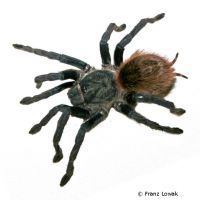Green Bottle Blue Tarantula (Chromatopelma cyaneopubescens)
| Green Bottle Blue Tarantula Chromatopelma cyaneopubescens | |
|---|---|
| Name | Green Bottle Blue Tarantula |
| Name Lat. | Chromatopelma cyaneopubescens |
| Family | Tarantulas |
| Family lat. | Theraphosidae |
| Order | Spiders |
| Order lat. | Araneae |
| Origin | Venezuela |
| Habitat | Forest |
| Diet | Live insects |
| Humidity | 50-65 % |
| Behavior | Semi-aggressive |
| Keeping | Individual |
| Care Level | Difficult |
| Housing | Semi humid terrarium |
| Breeding | Simple |
| Life Span | 5-10 years |
| Protection | No |
| Metric Units | |
| Size | 5-7 cm |
| Temperature Day | 25-28 °C |
| Temperature Night | 18-22 °C |
| Housing Size | 40 x 30 x 30 cm |
| US Units | |
| Size | 2"-2.8" |
| Temperature Day | 77-82 °F |
| Temperature Night | 64-72 °F |
| Housing Size | 15" x 10" x 10" |
Distribution and habitat
The venomous cyan blue tarantulas are native to the tropical forests of northern Venezuela, where they make their extensive living webs in tree cavities, between roots and plants usually near the ground.
Maintenance
For 1 animal a terrarium with a minimum size of 40 x 30 cm and a minimum height of 30 cm can be recommended as a guideline. The terrarium should be placed in a quiet place without sunlight.
You will need a terrarium structured with vertical cork tubes, roots and branches (hiding places), a solid 10-15 cm deep substrate of sand-clay-peat mixture, a small, shallow drinking vessel and for decoration artificial or potted plants (e.g. Ficus repens, Scindapsus aureus). A small portion of the substrate should always be kept slightly moist. Once a week the inside of the terrarium should be finely sprayed with water (humidity)
| Temp. day: 25-28 °C | Temp. night: 18-22 °C | Humidity: 50-65 % |
The lighting duration should be 8-12 hrs. depending on the season. A conventional light source is sufficient. Special lamps with high UV content are not necessary.
Diet
The food supply should consist of crickets, cockroaches, house crickets, maggots and grasshoppers and other arachnids. Adult animals can also be offered nest young mice. The prey animal is injected with a digestive juice with the biting tools (chelicerae), which liquefies the protein components and the prey can be sucked out (extracorporeal digestion). Juveniles can be offered food 1-2 times per week, adults only every one to two weeks. Under no circumstances should they be overfed, the basic rule being that the abdomen should be no more than 1½ times the size of the cephalothorax. Unaccepted food must be removed after 1-2 days. Refusal of food may indicate a natural phase of starvation or an impending molt. No food animals should be in the terrarium during molting, they could injure the spider.
A regular and varied diet promotes health and prevents deficiency symptoms.
Reproduction and breeding
The smaller males can be recognized by their bulbs folded in towards the body. The female lays up to 160 eggs in her burrow lined with webs 8-10 weeks after mating. The eggs are spun into a dense cocoon in which the larvae develop and are guarded by the female. The young leave the burrow after the third to fourth molt and feed independently. After 6-8 weeks, the young hatch.
Obligation to report
Make sure to inform yourself about any regulations on keeping or bans on keeping this animal in your state or home municipality (e.g. public order office). Your pet store will be happy to provide you with further information.
Important
They are nervous and irritable. In defense, they hurl irritant hairs with their hind legs against the attacker (bombard). These cause skin irritation and may cause corneal damage in the eyes as well as asthma-like symptoms. Care should also be taken when cleaning the terrarium, as irritant hairs can be stirred up from the substrate (safety goggles). A bite is very painful, the poison corresponds to that of a bee or wasp.
Crushed or held legs can be thrown off at a predetermined breaking point and regenerate completely after 1-2 molts.
The terrarium must have good ventilation without drafts and meet the species specific needs. Measuring devices such as thermometers, hygrometers, etc. are necessary. The lighting has to correspond to the species-specific day-night rhythm and has to be placed in such a way that the animals cannot injure themselves. The terrarium should be locked in such a way that neither unauthorized persons can open it nor the animals can escape. Special attention must be paid to thorough hygiene and impurities must be removed regularly
Further literature can be found in your pet store.
References
Text: petdata; Image: Franz Lowak
Source: ENGELMANN & LANGE (2011): Zootierhaltung - Tiere in menschlicher Obhut: Wirbellose, Harri Deutsch Verlag; KLAAS (2007): Vogelspinnen- Herkunft, Pflege, Arten, Verlag Eugen Ulmer
